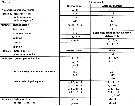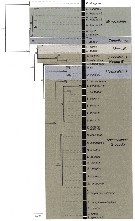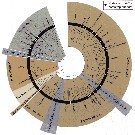|
|
 |
|
Calanoida ( Ordre ) |
|
|
|
Spinocalanoidea ( Superfamille ) |
|
|
| |
| | | |
| Spinocalanidae Vervoort, 1951 ( Spinocalanoidea ) | | Syn.: | no Arctokonstantinidae Markhaseva & Kosobokova, 2001 (p.319) | | Ref.: | Vervoort, 1951 (p.10, 72, Def.); Farran & Vervoort, 1951 g (n°39, p.3); Mazza, 1967 (p.99); Grice, 1971 (p.273, 279, key); Andronov, 1974 a (p.1005); Damkaer, 1975 (p.13, Genera Key); Bowman & Abele, 1982 (p.9); Razouls, 1982 (p.137); Fleminger, 1983 (p.605, 607, Genera Key, Rem.); Brodsky & al., 1983 (p.144, 147, 242, Genera Key); Park, 1986 (p.192, 193, 194); Mauchline, 1988 (p.724, 740: cuticular pores); Huys & Boxshall, 1991 (p.467); Razouls, 1991 (p.209, Rem.); Schulz, 1992 (p.176, Genera Key); Razouls, 1993 (p.311); Bradford-Grieve, 1994 (p.94); Schulz, 1996 (p.599, Rem., clé des G.); Bradford-Grieve & al., 1999 (p.878, 903, 904, 913: Genera key); Markhaseva & Kosobokova, 2001 (p.319, 323, Rem.); Ohtsuka & Huys, 2001 (p.461); Boxshall & Halsey, 2004 (p.12, 15; 49; 195: Def.; p.198: Genera Key); Schulz, 2004 (p.211: Rem.); Vives & Shmeleva, 2007 (p.820, part. Genera key); Markhaseva, 2008 (p.15, Rem.); Blanco-Bercial & al., 2011 (p.103, Table 1, Fig.2, 3, 4, molecular biology, phylogeny); Bode & al., 2017 (p.600, Fig.2, 3, 4, 5, Table I, II, III: morphology vs phylogeny); Laakmann & al., 2019 (p.330, fig. 2, 3, phylogenetic relationships); Hirai & al., 2020 (p.1, Fig.4: metabarcoding, Fig.8: OTUs distribution patterns)
Bradford-Grieve J.M., (2002 onwards). Key to calanoid copepod families. Version 1 : 2 oct 2002. http://www.crustacea.net/crustace/calanoida/index.htm  | | Rem.: | 10 G.: Damkaeria, Isaacsicalanus, Kunihulsea, Methanocalanus, Mimocalanus, Monacilla, Mospicalanus, Rhinomaxillaris, Spinocalanus, Teneriforma . |  issued from : E.L. Markhaseva in Russian J. Mar. Biol., 2008, 34 (1). [p.15]. Details of armament of mouthparts and P1 in Spinocalanidae. The table presents the most primitive condition of characters that has revealed for the genus. |
 issued from : E.L. Markhaseva & K. Schulz in Zootaxa, 2008, 1866. [p. 279]. Selected character states of Spinocalanoidea females (diagnostic characters of the family Arctokonstantinidae are in bold). Refernces: Hulsemann & Grice, 1963; Fosshagen, 1967, 1983; Park, 1970; Damkaer, 1975; Brodsky & al., 1983; Schulz, 1989, 1996, 2004; Markhaseva & Kosobokova, 2001; Boxshall & Halsey, 2004; Ivanenko & al., 2007; Markhaseva & Schulz, 2008. Nota: According to the authors (p.288), Arctokonstantinidae and Spinocalanidae belong to the Spinocalanoidea, the sister group of the Ryocalanoidea. Diagnostic characters considered to distinguis the superfamily Spinocalanoidea from Ryocalanoidea are not very strong. |
 Issued from : G.A. Boxshall & S.H. Halsey in An Introduction to Copepod Diversity. The Ray Society, 2004, No 166, Part. I. [p.195]. Armature formula of swimming legs P1 to P4. |
 Issued from : M. Bode, S. Laakmann, P. Kaiser, W. Hagen, H. Auel & A. Cornils in J. Plankton Res., 2017, 39 (4). [p.607, Fig.2]. Reconstruction of evolutionary relationships among Spinocalanidae. RAxML Maximum likelihood tree for the 18S rDNA fragments (1674 bp alignment). Numbers at the nodes represent the percentage bootstrap values > 50%. For details on species names see the considered species. Nota: Five genera of Spinocalanidae were identified morphologically: Spinocalanus Giesbrecht, 1888; Mimocalanus Farran, 1908; Monacilla Sars, 1905; Teneriforma Grice & Hülsemann, 1967; Mospicalanus Schulz, 1996. The phylogenetic analysis of the nuclear 18S gene fragment on a subset of 92 specimens yielded a tree with high bootstrap values Except for the genus Spinocalanus, all the other four genera were monophyletic [bootstrap support (BS): 87-100%]. The genus Spinocalanus, however, was polyphyletic. One highly supported clade consisted of S. magnus Wolfenden, 1904 and S. antarcticus Wolfenden, 1906 (BS: 100%), forming a well-supported clade (BS: 90%) with the genus Monacilla. A second clade was formed by a singletion sequence of S. angusticeps Sars, 1920, and a third large clade comprised all other identified Spinocalanus species (BS: 99%), forming a moderately supported (BS: 78%) clade with the genus Mospicalanus. From hereon we will refer to the three species S. magnus, S. antarcticus, S. angusticeps as Spinocalanus B and to all other Spinocalanus species as Spinocalanus A, following the morphological classification of Damkaer (1975). In the phylogenetic tree of 18S, the genera Miimocalanus and Teneriforma formed a highly supported (BS: 100%) sister-group to all other pelagic spinocalanid genera (figs.2 and 3). This pattern is also visible in the maximum likelihood tree of the mitochondrial COI, however, the nodes are not well supportede. The genera Monacilla and part of Spinocalanus B ( S. magnus, S. antarcticus) were sisters to S. angusticeps, Mospicalanus and Spinocalanus A (BS: 91%). This pattern differed slightly in the phylogenetic tree of COI, placing Spinocalanus B as sister to all remaining taxa, and Monacilla again as sister to S. angusticeps, Mospicalanus and Spinocalanus A. In the phylogenetic analysis of COI, Mospicalanus and Spinocalanus A could not be separated. Genetic divergence between the 7 clades (measured as uncorrected p distance) ranged between 0.3 and 2.9%. The divergence within clades ranged between 0 and 0.5%, except for Spinocalanus A, where p distance varied between 0.0 and 1.4% due to high divergences of Spinocalanus brevicaudatus Brodsky, 1950 and S. elongatus 2 [see fig. 3; and in species database. CR]. |
 Issued from : M. Bode, S. Laakmann, P. Kaiser, W. Hagen, H. Auel & A. Cornils in J. Plankton Res., 2017, 39 (4). [p.608, Fig.3]. Condensed Maximum likelihood tree for the mtCOI gene fragments (667 bp alignment). Nodes with bootstrap support <50% were collapsed, nodes with bootstrap support >90% are marked with black stars (for all bootstraps see Supplentary Fig.2. Currently acknowledged genera and species illustrated. For details species names see Table I [[indicated in the species database. CR.]] |
 Issued from : M. Bode, S. Laakmann, P. Kaiser, W. Hagen, H. Auel & A. Cornils in J. Plankton Res., 2017, 39 (4). [p.609, Fig.4]. Cluster analysis of the MALDI-TOF mass spectra based on Euclidean distance. Black stars at the nodes represent the percentage bootstrap values >90% (fotr all bootstraps >50%, see Supplementary Fig.3). Currently acknowledged genera and species are illustrated as in Fig.2 and 3. Black dots indicate additional taxa in comparison with COI data. Black square indicates incongruence to COI data. For details species names see Table I [[indicated in the species database. CR.]]. Nota: the last metasomal segment/urosomes of 193 spinocalanoid adult females were applying the MALDI-TOF MS technology according to available protocols (Riccardi & al., 2012; Laakmann & al., 2013). Additionally, seven whole animals were analysed to test whether they clustered correctly with the urosome-only samples. | | | | | Arctokonstantinus Markhaseva & Kosobokova, 2001 | | Ref.: | Markhaseva & Kosobokova, 2001 (p.320); Boxshall & Halsey, 2004 (p.198); Markhaseva, 2008 (p.15, Rem.) | | Rem.: | Cf.
Arctokonstantinidae | | | | (1) Damkaeria Fosshagen, 1983 | |
| | Ref.: | Fosshagen, 1983 (p.260, 261); Schulz, 1989 (p.195, Rem.); Bradford-Grieve, 1994 (p.95, Def.); Mauchline, 1998 (p.87, 89: F); Boxshall & Halsey, 2004 (p.198) ; Schulz, 2004 (p.198, Def.); Markhaseva, 2008 (p.15, Rem.); Renz & Markhaseva, 2015 (p.96, Table 4, fig.3, biogeography) | | Rem.: | Ce genre inclus antérieurement parmi les Bathypontiidae, est transféré par Bradford-Grieve (1994, p.95) dans cette famille. Total: 2 spp.: | | Remarques sur les dimensions et le sex-ratio: | | The mean female size is 0.870 mm (n = 4; SD : 0.0589) and the mean male size 0.718 mm (n = 4; SD = 0.0350). The size ratio (male : female) is 0.825.
The sex ratio is 1. | | | | Foxtonia Hulsemann & Grice, 1963 | | Ref.: | Hulsemann & Grice, 1963 (p.733); Razouls, 1982 (p.593); Fosshagen, 1983 (p.260); Razouls, 1993 (p.308); Mauchline, 1998 (p.66); Boxshall & Halsey, 2004 (p.198) | | Rem.: | Cf.
Arctokonstantinidae | | | | (2) Isaacsicalanus Fleminger, 1983 | |
| | Ref.: | Fleminger, 1983 (p.606, 607, 615); Schulz, 1989 (p.195, Rem.); Razouls, 1993 (p.311); Mauchline, 1998 (p.87: F); Boxshall & Halsey, 2004 (p.198); Markhaseva, 2008 (p.15, Rem.) | | Rem.: | Total: 1 sp. | | | | (3) Kunihulsea Schulz, 1992 | |
| | Ref.: | Schulz, 1992 (p.176); Mauchline, 1998 (p.87: F); Boxshall & Halsey, 2004 (p.198) ; Schulz, 2004 (p.206, Rem. : emend.); Markhaseva, 2008 (p.15, Rem.); Renz & Markhaseva, 2015 (p.96, Table 4, Fig.3, biogeography) | | Rem.: | Total: 2 spp. | | Remarques sur les dimensions et le sex-ratio: | | The mean female size is 0.597 mm. (n = 4, SD = 0.229). Adult males unknown. | | | | (4) Methanocalanus Ivanenko, Defaye & Cuoc, 2007 | |
| | Ref.: | Ivanenko & al., 2007 (p.38); Markhaseva, 2008 (p.15, Rem.) | | Rem.: | 1 sp.: | | | | (5) Mimocalanus Farran, 1908 | |
| | Ref.: | Farran, 1908 b (p.22); Sars, 1925 (p.34); Rose, 1933 a (p.86); Vervoort, 1946 (p.156); Davis, 1949 (p.23); Farran & Vervoort, 1951 h (n°40, p.3); Damkaer, 1975 (p.67, spp. Key); Brodsky, 1950 (1967) (p.137); Tanaka, 1956 c (p.387); Fleminger, 1983 (p.607, 615); Brodsky & al., 1983 (p.303, spp. Key) ; Razouls, 1982 (p.147); Schulz, 1989 (p.195, Rem.); Razouls, 1993 (p.311); Bradford-Grieve, 1994 (p.98, Def.); Mauchline, 1998 (p.87: F; p.90: M); Boxshall & Halsey, 2004 (p.198); Vives & Shmeleva, 2007 (p.821, spp. Key); Markhaseva, 2008 (p.15, Rem.) | | Rem.: | type: Mimocalanus. cultrifer Farran,1908 . Total: 10 spp. | | Remarques sur les dimensions et le sex-ratio: | | La moyenne des longueurs des femelles est de 2,082 mm (n= 10; S= 0,910; Cv= 0,437) et de 1,770 mm pour les mâles (n= 6; S= 0,643; Cv= 0,369). Le rapport des longueurs (M/F) est de 0,902 ou 90,2 % (n= 6; S= 0,091; Cv= 0,101) | | | | | Syn.: | Oxycalanus Farran,1908 b (p.25); A. Scott, 1909 (p.33); Wolfenden, 1911 (p.220); Hypsicalanus Wolfenden, 1911 (p.219) | | Ref.: | Sars, 1905 b (p.8); A. Scott, 1909 (p.34); Sars, 1925 (p.37); Sewell, 1929 (p.95); Rose, 1933 a (p.87); Vervoort, 1946 (p.157); Farran & Vervoort, 1951 h (n°40, p.3); Tanaka, 1956 c (p.395); Grice,1971 (p.274); Damkaer, 1975 (Déf., p.14, 62, clé spp.); Razouls, 1982 (p.149) Brodsky & al., 1983 (p.324, clé spp.); Fleminger, 1983 (p.607, 610, 612, 615); Mauchline,1988 (p.724); Schulz, 1989 (p.195, Rem.); Ferrari, 1992 (p.392, tab.3); Razouls, 1993 (p.311); Bradford-Grieve, 1994 (p.99, Déf.); Mauchline, 1998 (p.78: F; p.80: M); Bradford-Grieve & al., 1999 (p.914: clé spp.); Boxshall & Halsey, 2004 (p.198) ; Vives & Shmeleva, 2007 (p.828, spp. Key); Markhaseva, 2008 (p.15, Rem.) | | Rem.: | type: Monacilla typica . Total: 3 spp. + 1 indet. | | Remarques sur les dimensions et le sex-ratio: | | The mean female size is 2.188 mm (n = 28; SD = 0.1925), and the mean male size is 1.732 mm (n = 12; SD = 0.4078). The size ratio (male : female) is about 0.79. | | | | (7) Mospicalanus Schulz, 1996 | |
| | Ref.: | Schulz, 1996 (p.595); Boxshall & Halsey, 2004 (p.198); Markhaseva, 2008 (p.15, Rem.) | | Rem.: | Total: 1 sp. | | | | (8) Rhinomaxillaris Grice & Hulsemann, 1967 | |
| | Ref.: | Grice & Hulsemann, 1967 (p.39, 40, Rem.); Razouls, 1982 (p.593); Fosshagen, 1983 (p.260); Razouls, 1993 (p.309); Schulz, 1996 (p.599, Rem.); Markhaseva & Kosobokova, 2001 (p.319, 323, Rem.); Boxshall & Halsey, 2004 (p.198); Andronov, 2014 (p.92, 155) | | Rem.: | anciennement inclus dans la famille des Bathypontiidae. Type: Rhinomaxillaris bathybia Drice & Hulsemann,1967. Total: 1 sp. | | | | Sognocalanus Fosshagen, 1967 | | Ref.: | Fosshagen, 1967 (p.308, 313); Razouls, 1982 (p.594); Fosshagen, 1983 (p.260); Razouls, 1993 (p.309); Schulz, 1996 (p.599, Rem.); Mauchline, 1998 (p.87: F; p.90: M); Markhaseva & Kosobokova, 2001 (p.319, 323, Rem.); Boxshall & Halsey, 2004 (p.198) | | Rem.: | Cf.
Arctokonstantinidae | | | | (9) Spinocalanus Giesbrecht, 1888 | |
| | Ref.: | Giesbrecht, 1892 (p.52, 209); Giesbrecht & Schmeil, 1898 (p.31); Sars, 1900 (p.75); 1901 a (1903) (p.22); Wolfenden, 1906 (p.43); Esterly, 1906 a (p.55); van Breemen, 1908 a (p.28); Wolfenden, 1911 (p.215); Rose, 1933 a (p.84); Vervoort, 1946 (p.146); Davis,1949 (p.21); Brodsky, 1950 (1967) (p.122, spp. key); Farran & Vervoort, 1951 g (n°39, p.3); Tanaka, 1956 c (p.389); Park, 1970 (p.482, spp. Key F); Grice, 1971 (p.275, 279, spp. Key); Damkaer, 1975 (p.15, spp. Key, Rev.); Gardner & Szabo, 1982 (p.191); Razouls, 1982 (p.137); Brodsky & al., 1983 ( p.247, spp. Key); Fleminger, 1983 (p.607, 615); Mauchline, 1988 (p.724, pores cuticulaires); Schulz, 1989 (p.195, Rem.); Razouls, 1993 (p.311); Bradford-Grieve, 1994 (p.100, Def.); Mauchline, 1998 (p.78: F, p.80: M, figs.167, 169); Bradford-Grieve & al., 1999 (p.914: clé spp.); Boxshall & Halsey, 2004 (p.198); Vives & Shmeleva, 2007 (p.831, spp. Key); Markhaseva, 2008 (p.15, Rem.) | | Rem.: | type: S. abyssalis. Total: 29 spp. + 4 indét. | | Remarques sur les dimensions et le sex-ratio: | | La moyenne des longueurs des femelles est de 1,954 mm (n= 25; S= 0,696; Cv= 0,356) et de 2,032 mm pour les mâles (n= 19; S= 0,789; Cv= 0,388). Le rapport des longueurs (M/F) est de 0,953 ou 95,3 % (n= 16; S= 0,15; Cv= 0,157). Le sex-ratio (F/M) est de 1,315. Il est exceptionnel que la longueur des mâles soient supérieure à celle des femelles; la moyenne obtenue est due au sex-ratio et n'est pas confirmée par le rapport des longueurs (M/F) obtenu à partir des données femelles-mâles appariées. | | | | (10) Teneriforma Grice & Hulsemann, 1967 | |
| | Syn.: | Tanyrhinus Farran, 1936 a (p.85) | | Ref.: | Grice & Hulsemann, 1967 (p.22); Grice, 1971 (p.274); Damkaer, 1975 (p.15, 82, Rev.); Fosshagen, 1983 (p.260, 261, Rem.); Brodsky & al., 1983 (p.331); Fleminger,1983 (p.607, 615); Razouls,1982 (p.152); Schulz, 1989 (p.195, Rem.); Razouls, 1993 (p.311); Bradford-Grieve, 1994 (p.105, Def.); Mauchline, 1998 (p.87: F; p.90: M); Boxshall & Halsey, 2004 (p.198); Vives & Shmeleva, 2007 (p.846); Markhaseva, 2008 (p.15, Rem.) | | Rem.: | type: Tanyrhinus naso Farran,1936. Total: 4 spp. | | Remarques sur les dimensions et le sex-ratio: | | The mean female size is 0.965 mm (n = 8; SD = 0.1912), and the mean male is 0.830 mm. The size ratio (male : female) is about 0.87. | | | |
|
|
 Toute utilisation de ce site pour une publication sera mentionnée avec la référence suivante : Toute utilisation de ce site pour une publication sera mentionnée avec la référence suivante :
Razouls C., Desreumaux N., Kouwenberg J. et de Bovée F., 2005-2025. - Biodiversité des Copépodes planctoniques marins (morphologie, répartition géographique et données biologiques). Sorbonne Université, CNRS. Disponible sur http://copepodes.obs-banyuls.fr [Accédé le 05 janvier 2026] © copyright 2005-2025 Sorbonne Université, CNRS
|
|
 |
 |








